| LabGuy's World:
Cartrivision ~ The First ALL American Home VCR!
Newest Addition 03.06.08 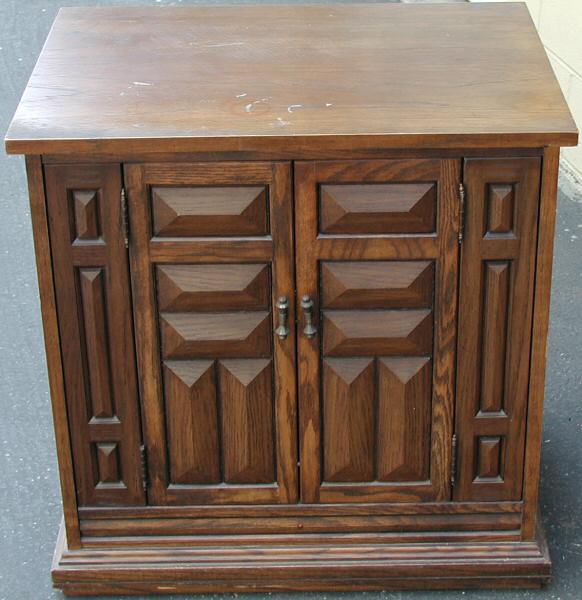 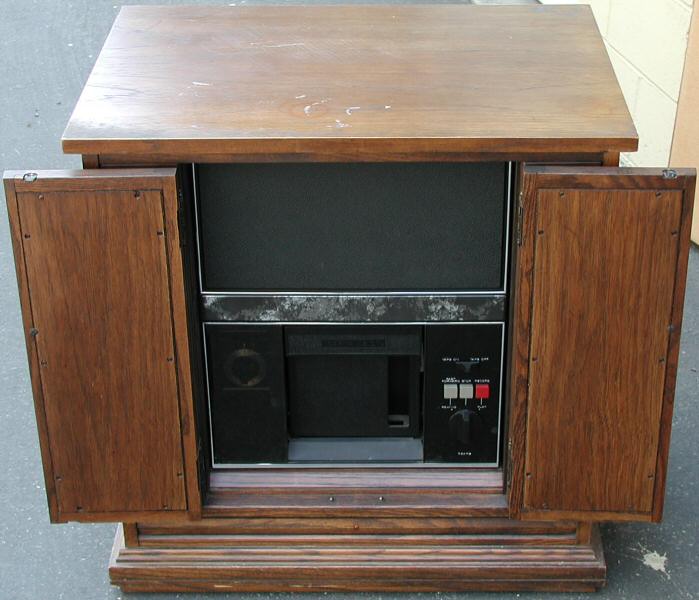 
Cartrivision ~ The First ALL American Home VCR The year was 1972. This is the first VCR made in the U.S.A. for consumers. The product flopped horribly ~ of course. Shown in the photos above, is a beautiful example of an end table model. These were large machines and had they had to blend in with the living room decor. The Cartrivision VCR was typically intended to be built into a console style 25" color TV, a popular screen size at that time. Sets like that were produced by Sears, Montgomery Wards, Curtis Mathes, just to name a few. The third photo is of the interior front of the mechanism. Very few Cartrivision VCRs were sold new. Thousands were sold surplus through outlets like Olsen Electroncis or private clubs. Initially they were sold here in the San Jose / south bay area (Silicon Valley, where else?). Steve Wozniak had one, as well as the fellows who founded Newtek, makers of the Video Toaster! I wonder if they still have their Cartrivision VCRs? (Someone please hook us all up!) 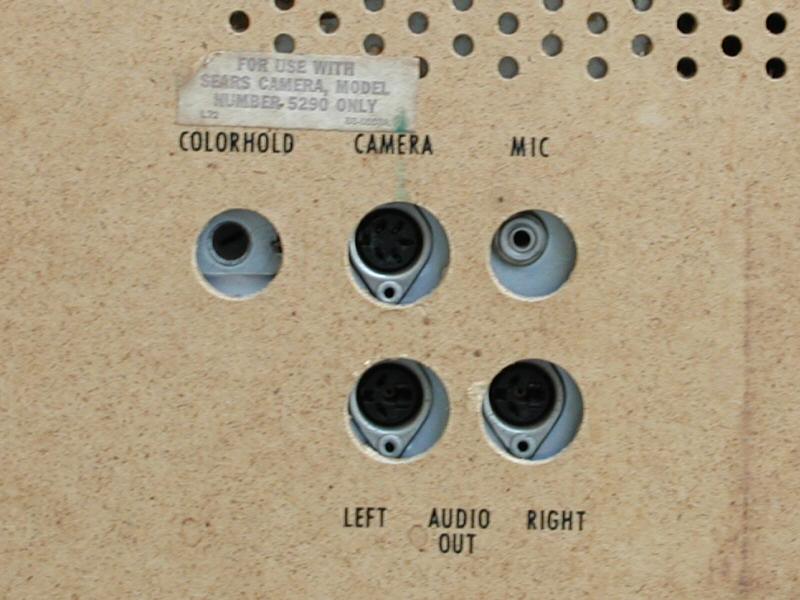
Cartrivision Rear Connector Panel The photo above is of the connector bay on the rear of the end table model. There is a screwdriver access "color hold" control pot, camera and microphone inputs plus left and right audio out. The Cartrivision VCR could play stereo audio from prerecorded cassettes, but only recorded audio in mono. More precisely, it records one input channel onto both audio tracks. In the case of bi-lingual programming, a clunky shorting plug was put into either the right or left audio output to mute the audio from that channel. These audio output jacks work like earphone jacks, inserting the plug cuts of the audio that went to an internal RF converter. The RF unit was NOT standard equipment. Being the first (and only) version of the VCR, there were some obvious (to us today) ergonomic issues with this product. Of course, this is only a detail that in no way detracts from the genius of this system! It was the first of a kind. Minor issues, like these, were inevitable. 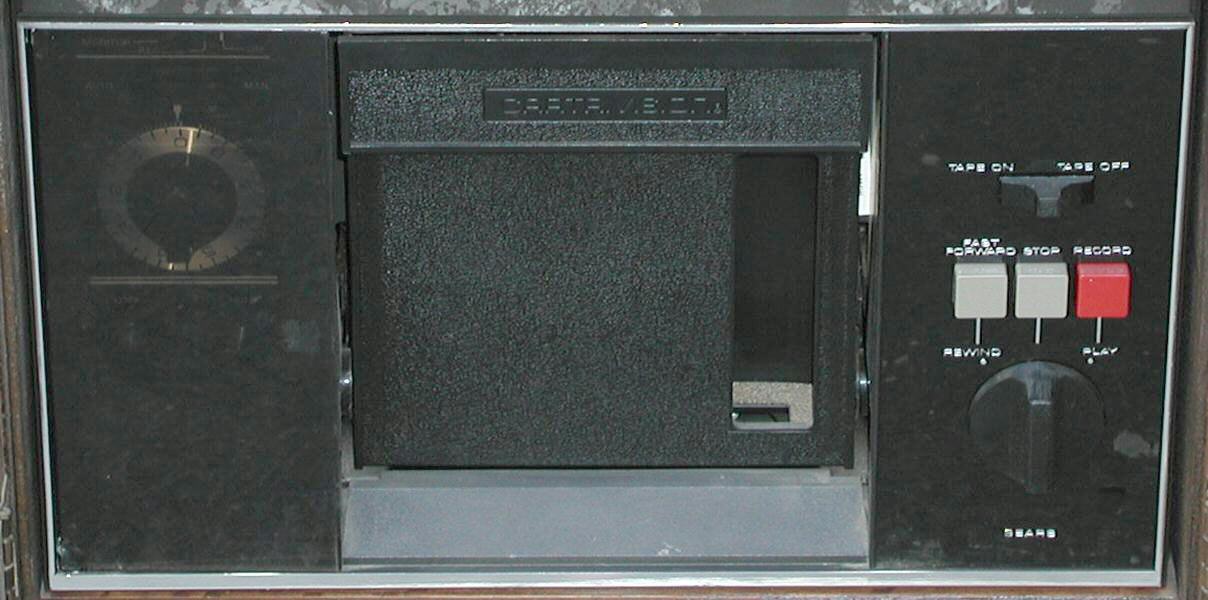
"Ergonomics" or "Human Engineering" Disaster Zone! The term, "user friendly" is never used in the same sentence as the word Cartrivision. (Except here!) To my trained eye, this product has a lot of "Ampex" in it. Note that to go into fast forward, you press down the FF button and turn the function selector knob to the rewind position. Kind of like going into record mode. (Press & hold record button, turn selector to play) This takes two hands and even then is cumbersome to say the least. Notice that the positioning of the controls is near the height of most people's ankles! Behind the smoked cover, on the left, are two additional mode switches and the mechanical sleep timer. The logic of these switches is bewildering in its (unnecessary) complexity. Of course, I say this with a contemporary attitude. Keep in mind, that there were no microprocessors back then! To be fair, the Cartrivision VCR does contain some (primitive) integrated circuits. But, none of those were used in the mode control logic. All control logic in the VCR was by means of mechanical switches and relays, mostly. Some transistorized time delay circuits are used, but do not constitute digital logic as we understand it today. The rest of the electronics can be described as "discrete transistorized circuitry". Easy as heck to repair, expensive and labor intensive to assemble. This is what is most responsible for the $1,600 selling price in 1972 dollars! Imagine what a Pentium (R) processor would cost if each and every transistor had to be soldered in by hand! Can you say, "Billions and billions of dollars?" The Ampex small format VTRs also had a less than ideal user interface and I believe this method was carried forward in the design of these VCRs. They required the operator to throw multiple levers to select electronic modes separately from the deck functions levers. Which is also a very cumbersome two handed exercise in coordination. Operations may have seemed logical to the engineers, but this is not what the typical consumer could, or can, deal with. It should come as no surprise that Cartrivision was essentially started by a group of maverick Ampex engineers and managers. After having said all that, I want to be clear that I am not knocking any Ampex or Cartrivision products or engineers. I admire both companies and their people a great deal. The point is that when engineers are designing a bleeding edge product, the human factors may not be given the highest priority. These things were too big, too clunky and far too expensive. This product was produced through a subsidiary of Avco / Embassy entertainment called Cartridge Television, Incorporated. The advantage of this was the huge collections of films already owned by Avco. It was a logical idea. My Friend, Luke Perry, tells the story of Cartridge Television much better than I can, so to learn more about the company itself, visit Luke's web page: [Cartrivision: A unique way of looking at things]. Another excellent source of information, taken from the consumer's point of view, is at the [CED Magic Web site]. CED Magic is a site devoted to the RCA Selectavision Capacitive Video Disc players. CED Magic also covers many many obsolete video products. Both sites are great reading! . 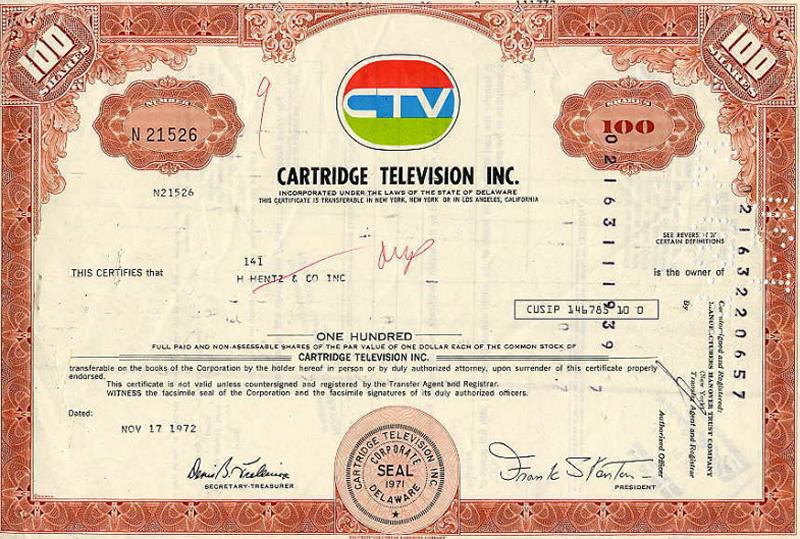
Cartrivision Stock Certificate The recording process is what is called skip field. The machine records every third field of video and plays it back three times. This gives an effective 10 frames per second at only 240 scan lines! A primitive video compressor! But, it was full COLOR! What a wonderful product! I would like to think that if they had simply put a transparent cover on the front of the unit, leaving those marvelously Rube Goldberg insides visible, this format would still be alive today. Naaaaa! The camcorder would be too huge! When the machine is running, the 10 inch diameter head wheel, and the entire circuit board containing the record / playback head(s) electronics, spins around 10 times a second! What a wonderfully goofy thing to see. Even a blank tape can be entertaining with one of these filling your living room! Shown in the first photo above is the tape drive mechanism. A second component (shown farther down this page), containing most of the electronics nick named the "fish tank", is almost as large as the tape drive mechanism itself! The VCR shown above, is one that was donated to LabGuy's world about a year ago. That particular deck will require a lot more work to restore it, than the latest decks I just obtained just last month. . 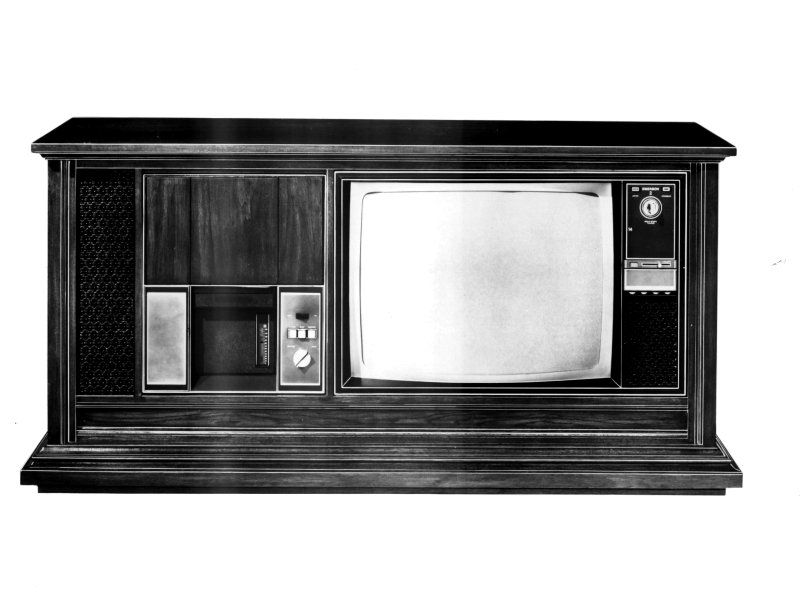
An Emerson TV / VCR Console Model The VCRs were so big, they were usually bundled in the same cabinet with a 25 inch color TV like the Emerson monster shown above! They were sold through major department stores like Montgomery Wards and Sears. The machines were sold on the third floor in the TV department while the tapes were sold on the first floor in the records and 8 track department! The sales people on these floors were unaware of this most of the time! The system sold for over $1600 back then. No sale! That's equivalent ot about $3300 in today's dollars. Cartridge rental was where the company planned on making the big bucks. At least they predicted that market correctly! The rental cassettes could be distinguished easily from the blank tapes. The rental tapes were red and the blank recordable tapes were black with yellow labels. The rental cassettes also could not be rewound in the home deck. They had to be rewound on a special machine at the video store! (See below) This guaranteed that the consumer could only watch the movie once per rental! I'm glad JVC didn't do that to VHS! Betamax would have taken over, eh? A small black and white camera was available for home recording. The camera was manufactured by Eumig of Austria. To this day, this company is studied in business schools as the prime of example of "how not to do it"! Cartridge Television Incorporated came and went in less than three years! One other extenuating factor that led to the downfall of Cartrivision was that almost all of the first run cassettes went bad from humidity in the warehouse! That was simple bad luck. Their legacy is that they left behind literally thousands of brand new unsold VCRs and tens of thousands of movie cartridges. The video cameras were a standard item in hundreds of amateur television shacks as well. Both the Cartrivision VCRs and cameras still turn up on the surplus market in respectable quantities to this very day. New Addition! 03.06.08 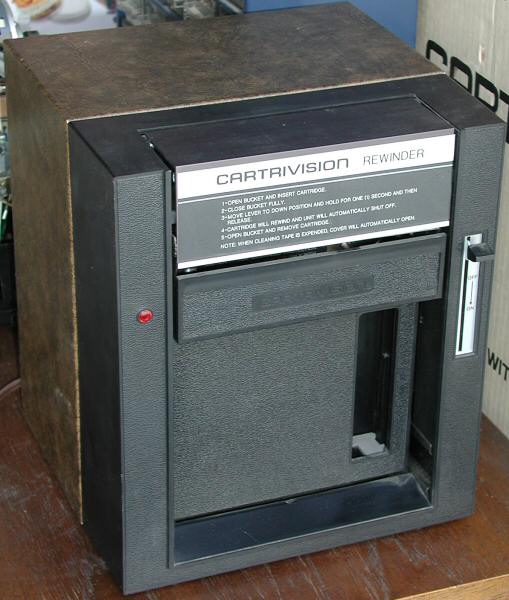 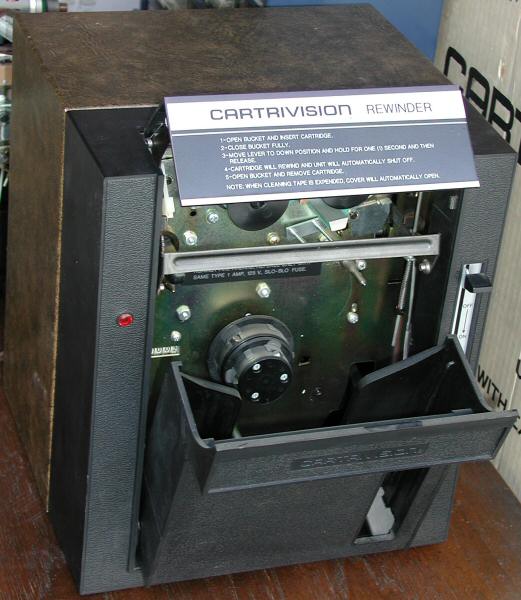 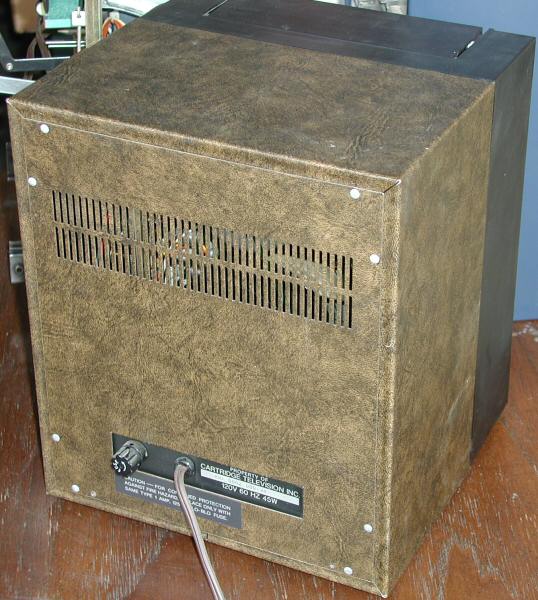
Cartrivision rental tape (red cartridge) rewinder The red Cartrivision cassettes were for rental only. The consumer could not rewind the red cassettes in the home machine. To rewind these, they were returned to the rental center and were then rewound on a special machine, shown above. This is packaged in quite an industrial, leatherette covered, steel case. This machine rewound the cassette to the proper tension and cleaned the surface of the tape prior to the next rental. It is claimed that the machine logged the number of times the tape was rewound, though, I am not sure how this was done. Automatically or with a paper based (human powered) tracking system? The text of the instructions shown on the flip up cover reads as follows: . 1. Open bucket and insert cartridge. 2. Close bucket fully. 3. Move lever to down position and hold for one (1) second and then release. 4. Cartridge will rewind and unit will automatically shut off. 5. Open bucket and remove cartridge. NOTE: When cleaning tape is expended, cover will automatically open. . 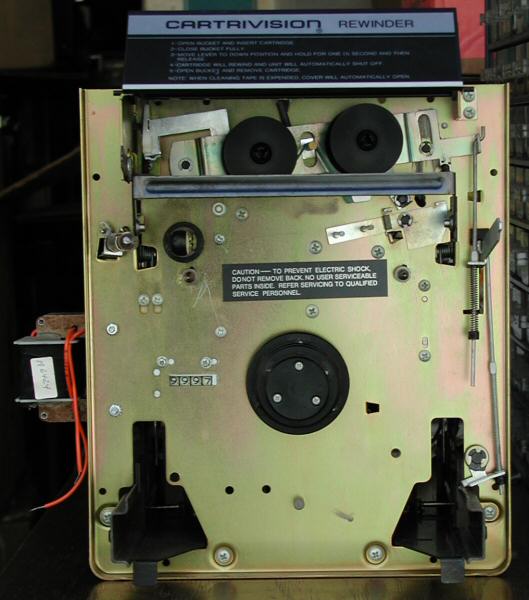 
Internal view of the rental tape rewinder The mechanism of the rewinder appears to have been able to fast forward the tape to the end before rewinding and cleaning it. The two photos above let us clearly see the insides of the rewinder machine. Note the two spools that look like typewriter ribbons at the top of the first photo. These contain a cloth (I think) cleaning tape that touches the surface of the video tape during rewind. The large motor performs rewind, while the smaller motor, to the right of the second photo, performs the fast forward drive. New Addition 02.07.28 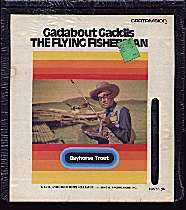
A Cartrivision cartridge of Gadabout Gaddis! and my Dad's favorite fishing show! I have this one special tape and it's a double collector's item! It's still in the original cellophane wrapper with the original price tag on it. This tape sold for: $6. 50! (around 1972) It's a 24 minute episode of: Gadabout Gaddis, the Flying Fisherman, entitled: "Bayhorse Trout". (Copyright 1965 G.G. Productions, Inc. ) . My Dad and I used to watch his show every Sunday afternoon before I was in high school, sometime in the late 1960's. Gadabout would fly his private Cessna airplane, hither and yon, just to go fishing! Personally, I'm not very enthusiastic about fishing. So, I was sure glad that Dad didn't own a small plane! For me today, this tape has triple collector's value, it's a vintage video collectors' item, it's a Gadabout Gaddis collectors' item and it's a link to my own heritage! Every time I look at it, I remember my Dad.... [HOME]......[CONTINUE WITH RESTORATION PROJECT]......[VIDEO RECORDERS MUSEUM] Last updated: January 09, 2005 |